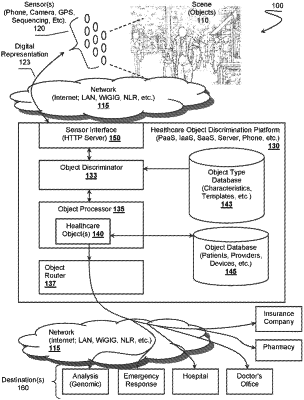| CPC G16H 10/60 (2018.01) [G16H 40/67 (2018.01)] | 20 Claims |

|
1. A system for routing healthcare objects, the system comprising:
memory configured to store one or more discriminator algorithms and computer-executable instructions;
a destination device including a display;
at least one sensor configured to obtain a digital representation of a scene; and
at least one processor configured to execute the computer-executable instructions to:
receive the digital representation of the scene from the at least one sensor;
derive a set of discriminator characteristics via execution of the one or more discriminator algorithms on the digital representation according to data modalities within the digital representation, the set of discriminator characteristics comprising a vector of discriminator characteristics, the vector of discriminator characteristics comprising multiple vector members, and each vector member corresponding to a different modality of data;
discriminate objects in the scene by recognizing an object as a healthcare object type based on the set of discriminator characteristics;
instantiate a healthcare object from the recognized object according to the healthcare object type;
route the healthcare object to the destination device according to routing rules associated with the healthcare object; and
cause the destination device to enable rendering of a user interface on the display in response to receiving the healthcare object.
|